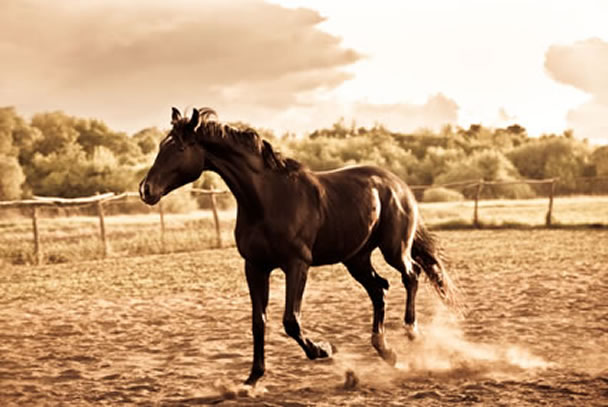Get a slower collected lope

When training your horse to have a slow, collected lope, the first step is to understand clearly what the horse must do with his body to slow down and collect himself. Too many people think that a headset is the same thing as collection; in fact, nothing could be further from the truth.
Artificially forcing a headset with gadgets or a harsh bit results in a low-headed western pleasure horse with a broken, four-beat lope, who looks like he's trying to roll a peanut along the ground with his nose. Such horses are the bane of American Quarter Horse Association and other stock breed shows, and a source of ridicule among equestrians in other disciplines.
The AQHA and its fellow stock horse associations have started to penalize horses with this sort of training heavily, especially at the upper level of showing. To avoid producing a peanut-roller, slow your horse's lope by helping him redistribute his weight over his hindquarters and bring his hind legs further underneath himself with every stride, while arching softly through his back and neck. To do this, your horse must become strong and balanced. You can help this process along with some simple exercises.
Continuous Loping
Most riders never canter their horse continuously for more than five minutes or so at a time. If you never let your horse lope for extended periods on a relaxed rein, he never has a chance to figure out for himself that it's best for him to conserve his energy and use his body efficiently to carry you in the most comfortable way possible.
To start the continuous loping exercise, warm your horse up for several minutes at the walk and trot, preferably in an arena with a fence. Sit with deep, following seat in the saddle. With your horse on a loose rein, ask for a canter on the correct lead. Depending on your horse's current fitness level, continue to canter for at least ten minutes, and up to twenty minutes.
The horse's job is to maintain gait and direction; your job is to stay out of his way -- and especially out of his mouth -- unless he breaks to a trot. If he breaks gait, calmly move him back into a canter. You will probably find that he canters fast and off-balance for the first few minutes, before gradually adopting a slower and more balanced lope. Stop when he maintains a nice, comfortable, balanced lope for at least a minute or so.
As you repeat the exercise over the course of a couple of weeks, your horse will move into the slower lope more and more quickly. Because he knows that he may have to lope for a long time, he learns that it would be in his best interest to pace himself. He also builds up his loping muscles. Make sure to lope equally in both directions so that he does not become one-sided. Before long, your horse will immediately pick up a pleasant lope whenever you ask, and at this point, he is ready for further training in collection.
Slowing the Lope With Circles
When training a horse to have a slow collected lope, it's vital that you don't start to rely on the bit and the reins too much. A good exercise to prevent this is a simple circle. When a horse does a small circle while staying balanced, he will naturally slow and collect himself. To begin the collection process, pick up a nice lope along the arena rail. Let the horse settle into his rhythm, then use the inside rein (or neck rein) to ask for a circle that is as small as he can comfortably do while still maintaining gait.
Hold the circle until you feel the horse slow, and his back come up underneath you, which indicates that he is stepping up underneath himself and collecting. When you feel this, let the horse go straight again. He will most likely go right back to his normal lope, which is fine. Let him go for a minute, then circle again until he slows and collects. Don't overdo it on the first few rides; collection uses muscles that your horse hasn't developed yet.
Over a period of several weeks, gradually increase the amount of time you ask for collection. Your horse will slowly improve in his ability to hold the collected lope. As time goes on, you will be able to remind him to collect simply by lifting the inside rein and bending him slightly around your inside leg, instead of having to do an actual circle. Be patient, give your horse and yourself plenty of time to learn and build muscle, and you will end up with a horse who lopes slowly and beautifully on a draped rein.
References
Parelli, Pat. Savvy System Part 2 - Harmony. Parelli Natural Horsemanship,1999.
Parelli, Pat. Savvy System Part 3 - Refinement. Parelli Natural Horsemanship,1999.
Add your comments
comments powered by Disqus
